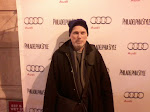2 February 1809
The Walnut Street Theatre at 9th Street in Philadelphia first opened its doors on 2 February 1809. To celebrate their 200th anniversary, the Walnut has mounted a new production of A Street Car Named Desire. A German director friend groaned at the news; she cattily if wittily remarked: a chestnut on Walnut! But it’s a great play. And in September 1947 it happened to premiere at the Walnut starring Jessica Tandy, Kim Hunter, Karl Malden and Marlon Brando. People who have seen the subsequent film may not understand how the Hays Office and the Legion of Decency eviscerated the play.
The play moves slowly by contemporary standards, slow as a novel, slow as the Mississippi. It’s set in New Orleans. Blanche Dubois played here expertly by Susan Stevens arrives at her sister’s house in the French Quarter -- only to “blanche” at the violence and sexuality of her Polish brother-in-law, Stanley Kowalski (Jeffrey Coon). The play is easily construed as a 40s Freudian battle between Blanche and Stanley for the soul of Blanche’s sister, Stella (Sandra Struthers). Stella is the vibrant and healthy star to which the ethereal Blanche and the carnal Stanley can only aspire.
Stanley wins. He breaks Blanche. “Whoever you are,” a confused Blanche says to the psychiatrist who leads her away at the play’s end, “I have always depended on the kindness of strangers.” Williams himself finally succumbed to just such a liquor and pill-fueled madness. And what did the Hays Office change?
The Blanche in the play had unknowingly married a closeted gay man. When she learned the truth, she cruelly drove him to suicide. Such things happen; and their representation ran uncensored on a Philadelphia stage in 1947. But a mass audience in a 1950s movie house could not be subjected to, as they said, degenerates and perverts. Williams was forced to re-imagine Blanche’s husband as poet. He was a poet killed by his wife’s bad notice.
Vivien Leigh, who played Blanche in London and in the subsequent film, considered the change ludicrous. Leigh of course knew madness firsthand. And yet, as a poet myself, I kind of like the film’s suicidal husband. My aunt said very mean things about my verse. If I had shot myself like Blanche’s husband, she’d have felt really bad. I should have done it! It’s too late now though. My aunt ultimately went crazier than Blanche. But the etiology was not some guilty Freudian unconscious. It was a brain tumor.
Yes, being a poet can be a serious bitch. Nor is it ever easy being gay -- even in 2009. The beautiful gay daughter of two of my most brilliant friends recently killed herself. Yet perhaps it’s easier to be gay now than it was in 1947. Some things may eventually change for the better. People used to believe in progress. Great plays like Street Car Named Desire help.
[Libby Rosof and Roberta Fallon posted an earlier version of this “review” the morning after opening night in their lively Philly Art Blog:
http://fallonandrosof.blogspot.com/2009/01/streetcar-on-walnut-street-blanche.html
It is festooned with photos and a clip from the film.]
The play moves slowly by contemporary standards, slow as a novel, slow as the Mississippi. It’s set in New Orleans. Blanche Dubois played here expertly by Susan Stevens arrives at her sister’s house in the French Quarter -- only to “blanche” at the violence and sexuality of her Polish brother-in-law, Stanley Kowalski (Jeffrey Coon). The play is easily construed as a 40s Freudian battle between Blanche and Stanley for the soul of Blanche’s sister, Stella (Sandra Struthers). Stella is the vibrant and healthy star to which the ethereal Blanche and the carnal Stanley can only aspire.
Stanley wins. He breaks Blanche. “Whoever you are,” a confused Blanche says to the psychiatrist who leads her away at the play’s end, “I have always depended on the kindness of strangers.” Williams himself finally succumbed to just such a liquor and pill-fueled madness. And what did the Hays Office change?
The Blanche in the play had unknowingly married a closeted gay man. When she learned the truth, she cruelly drove him to suicide. Such things happen; and their representation ran uncensored on a Philadelphia stage in 1947. But a mass audience in a 1950s movie house could not be subjected to, as they said, degenerates and perverts. Williams was forced to re-imagine Blanche’s husband as poet. He was a poet killed by his wife’s bad notice.
Vivien Leigh, who played Blanche in London and in the subsequent film, considered the change ludicrous. Leigh of course knew madness firsthand. And yet, as a poet myself, I kind of like the film’s suicidal husband. My aunt said very mean things about my verse. If I had shot myself like Blanche’s husband, she’d have felt really bad. I should have done it! It’s too late now though. My aunt ultimately went crazier than Blanche. But the etiology was not some guilty Freudian unconscious. It was a brain tumor.
Yes, being a poet can be a serious bitch. Nor is it ever easy being gay -- even in 2009. The beautiful gay daughter of two of my most brilliant friends recently killed herself. Yet perhaps it’s easier to be gay now than it was in 1947. Some things may eventually change for the better. People used to believe in progress. Great plays like Street Car Named Desire help.
[Libby Rosof and Roberta Fallon posted an earlier version of this “review” the morning after opening night in their lively Philly Art Blog:
http://fallonandrosof.blogspot.com/2009/01/streetcar-on-walnut-street-blanche.html
It is festooned with photos and a clip from the film.]

